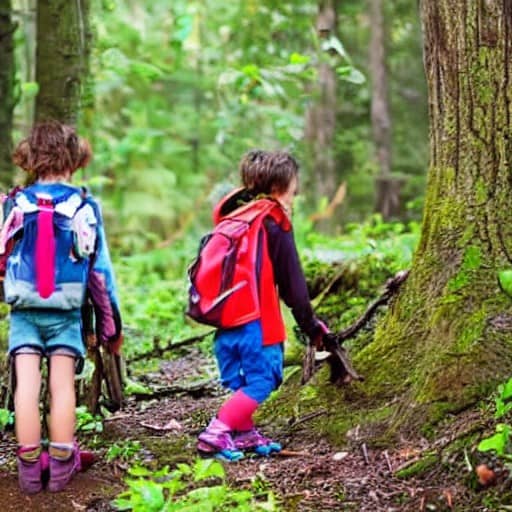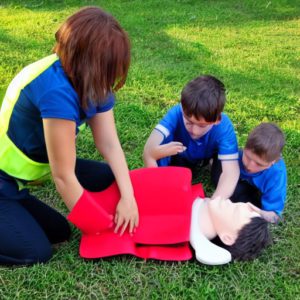Survival Skills Unleashed: A Parent’s Guide for Kids
Teaching children how to survive in dangerous situations is an essential component of their development. Not only does it ensure their safety, but it also instills in them a sense of self-confidence and the ability to bounce back from adversity. Providing children with the opportunity to acquire practical skills means that they are more prepared to deal with a variety of scenarios they may encounter in a world where unexpected events can occur.

Basic First Aid Skills
One of the most important investments that can be made in the health and safety of children is the teaching of fundamental first aid skills. Not only do these foundational skills equip children with the ability to appropriately respond to small injuries, but they also foster a sense of responsibility and self-efficacy throughout their development.
To begin, you should educate them about the significance of cleanliness in the treatment of wounds. Emphasize the need to fully wash one’s hands before touching any kind of wound first. Teach children how to clean small wounds with gentle soap and warm water, making sure that they remove any debris or dirt that may be present in the wounds. The establishment of this fundamental understanding of hygiene creates the foundations for the prevention of infection and the promotion of the comprehensive healing process.
Now that we have that out of the way, teach youngsters the correct way to treat minor wounds. Provide them with an introduction to the various types of sterile dressings and stress the significance of picking a suitable size to cover the wound adequately. Before applying the dressing, you should encourage them to use a clean cloth to gently pat the wound dry. In addition, please explain the relevance of using an antiseptic ointment to avoid infection and to aid recovery.

It is important to demonstrate how to properly apply bandages. It is important to instruct them on the proper way to wrap a bandage around the incision, making sure that it is snug but not too tight. Stress the need to attach the bandage using clips or sticky strips and ensure that it remains in place to get the highest possible level of protection. Children need to understand that the bandage serves two purposes: it secures the dressing in place and it protects the wound from any external pollutants.
One more essential ability that they possess in their first aid toolkit is the ability to use adhesive strips. To properly close small cuts or wounds, demonstrate how to properly use adhesive strips and explain why it is important for the strips to be securely applied without being overly tight. You should encourage them to determine the severity of the wound and select the form of closure that is best suitable for the wound.
Make sure to emphasize how important it is to maintain composure and concentration during this procedure. Instill in them the belief that the acts they take in the course of administering first aid can have a beneficial impact on the health of another individual. Instilling these fundamental first aid skills in children not only helps them develop a practical understanding of injury care but also helps them cultivate a feeling of empathy and prepares them to deal with unforeseen situations.
Fire Safety Skills
Teaching children about fire safety is a critical component of their overall education because it provides them with the knowledge they need to navigate potentially dangerous situations responsibly. Not only does it require teaching the mechanics of building and extinguishing fires, but it also involves developing a profound awareness of the principles that govern fire safety and cultivating a sense of responsibility when dealing with activities that are related to fire.
 To begin the lesson, it is important to emphasize the need to follow fire safety rules. In addition to highlighting the potential risks that are linked with fire and the necessity of exercising the utmost caution, these guidelines establish a framework for responsible behavior. Not only should children be instructed to follow these guidelines, but they should also be taught to comprehend the rationale behind them, which will contribute to the development of a proactive approach to safety.
To begin the lesson, it is important to emphasize the need to follow fire safety rules. In addition to highlighting the potential risks that are linked with fire and the necessity of exercising the utmost caution, these guidelines establish a framework for responsible behavior. Not only should children be instructed to follow these guidelines, but they should also be taught to comprehend the rationale behind them, which will contribute to the development of a proactive approach to safety.
To move on to the more practical aspects, instruct them on how to construct a fire securely. It is important to begin by finding an acceptable place, one that is free of flammable objects and is exposed to the air. Advise them on how to gather resources responsibly, with a particular emphasis on the utilization of dry leaves, twigs, and small branches. Show them how to properly construct a fire lay and educate them on the many sorts of fire lay, such as teepee and log cabin styles, depending on the circumstances.
In addition to this, knowing how to safely put out a fire is of equal importance. Instruct youngsters on the sequential steps involved in extinguishing a fire, beginning with the significance of having a bucket of water or sand easily available in the event of an emergency. To ensure that all of the embers are completely extinguished, please demonstrate how to pour water over the fire. To ensure that the area is cool to the touch, it is imperative that the ashes be stirred and additional water is added. Instill the notion of “leave no trace” to emphasize how important it is to completely clean up the area where the fire destroyed the building.
It is quite beneficial to be able to reinforce these concepts through the use of practical demonstrations and hands-on experiences. Children can apply their knowledge in a controlled context through the use of supervised fire-building exercises, which are beneficial to their confidence and competence. This strategy, which emphasizes the need for human responsibility and accountability when dealing with fire, also affords the chance to emphasize the value of the aforementioned concepts.
At the end of the day, the objective is not simply to instruct the mechanics of fire-related tasks; rather, it is to inculcate a respect for fire safety that will last a lifetime. Through the cultivation of this knowledge and responsibility, children are better prepared to navigate outdoor activities and emergencies, which contributes to their overall safety as well as the safety of those who are in their immediate vicinity.
Identifying and Using Tools
It is a transforming educational experience to provide children with the knowledge of identifying and using tools. This not only fosters practical skills, but it also fosters a sense of responsibility and resourcefulness in the children. Not only does the process require familiarising kids with physical instruments, but it also involves establishing in them a profound awareness of the purpose of tools, the correct way to use them, and the significance of conducting themselves responsibly when managing them.
 Start by introducing fundamental tools, such as a Swiss Army knife that is suitable for the child’s age. This multipurpose tool serves as an ideal starting point, showing a variety of features and applications through its use. It is important to highlight the adaptability of each component and to provide an explanation of the conditions that may call for the use of various tools. An initial exposure like this piques one’s interest and establishes the groundwork for a more comprehensive understanding of the tool.
Start by introducing fundamental tools, such as a Swiss Army knife that is suitable for the child’s age. This multipurpose tool serves as an ideal starting point, showing a variety of features and applications through its use. It is important to highlight the adaptability of each component and to provide an explanation of the conditions that may call for the use of various tools. An initial exposure like this piques one’s interest and establishes the groundwork for a more comprehensive understanding of the tool.
While you are delving into the more practical aspects of tool usage, it is necessary to instruct youngsters on how to handle tools responsibly and securely. To begin, begin by conveying a fundamental concept of tool safety, putting an emphasis on the significance of respecting the capabilities and limitations of the tool under consideration. It is important to demonstrate good handling skills, such as holding tools with a firm grip and keeping a safe distance from sharp edges.
Help youngsters understand how to properly use each tool by guiding them through the process. The significance of precision and attention should be instilled in the student, regardless of whether they are using a screwdriver, pliers, or a knife to cut anything. It is important to emphasize the relevance of utilizing the appropriate instrument for the appropriate work and to cultivate an appreciation for the efficiency and effectiveness that come with effectively selecting the appropriate tool.
Hands-on activities that are supervised should be incorporated to provide practical experience. Encourage children to participate in projects that are easy to understand, suitable for their age, and provide them the opportunity to put their newly acquired knowledge into practice. The lessons that were learned are not only reinforced but also confidence and a sense of success are built up as a result of this.
In addition to this, emphasize the importance of taking responsibility for the upkeep of tools. Teach youngsters the fundamentals of cleaning, storing, and caring for tools to ensure that they will last for a long time and perform to their full potential. Education about tools encompasses more than just the act of using them; it also helps students develop a more comprehensive notion of ownership and stewardship.
In the end, the objective is to cultivate a generation that regards tools not merely as instruments but rather as important resources that require respect and appropriate treatment. The development of children’s practical skills, critical thinking abilities, and a profound awareness of the role that tools play in problem-solving and self-sufficiency can be accomplished through the implementation of an all-encompassing strategy for tool education.
Navigation Skills
Providing children with the ability to navigate the big outdoors as well as the intricacies of the world around them is comparable to providing them with a compass for life. This means that children will be able to traverse both environments. The base of these abilities is not only the teaching of the fundamentals of map reading but also the instillation of a profound comprehension of the cardinal directions through the utilization of a compass is the foundation.
 Begin the session by explaining the fundamental abilities necessary for reading maps. One of the most important things for children to understand is that maps are visual representations of space and topography. The first step is to create maps that are easy to comprehend, possibly of their neighborhood or a nearby park. You should instruct them on how to recognize important components such as symbols, landmarks, and scale. As their level of expertise increases, progressively introduce more complicated maps, which will support a gradual evolution in their ability to read maps.
Begin the session by explaining the fundamental abilities necessary for reading maps. One of the most important things for children to understand is that maps are visual representations of space and topography. The first step is to create maps that are easy to comprehend, possibly of their neighborhood or a nearby park. You should instruct them on how to recognize important components such as symbols, landmarks, and scale. As their level of expertise increases, progressively introduce more complicated maps, which will support a gradual evolution in their ability to read maps.
Children gain a better understanding of the essential points on a compass, which are north, south, east, and west, when they are gradually introduced to the cardinal directions. Explain the significance of these directions by relating them to examples from the actual world, such as the sun rising in the east and the sun setting in the west. Make learning about the cardinal directions more interesting and memorable by incorporating games and activities that need hands-on participation.
It is important to get the compass known as a useful instrument for navigating in the wilderness. It is important to instruct children on how to properly hold a compass and how to align it with the magnetic field of the Earth. To assist with determining other directions, demonstrate how the needle points in the direction of the north. Encourage children to participate in hands-on activities in which they navigate from one location to another using both the map and the compass, thus strengthening their comprehension through the application of the information.
In addition, you should include the idea of orienteering, which is a recreational activity that combines reading maps and navigating the world. In addition to adding an element of excitement, this not only helps them improve their talents in a way that is both dynamic and enjoyable.
Challenge the youngsters with more sophisticated exercises as they grow in their navigation skills. Some examples of these exercises include planning routes, recognizing geography, and estimating distances. To facilitate the smooth incorporation of navigational skills into their everyday life, you should encourage students to apply the knowledge they have gained in everyday situations.
In essence, the objective is to foster a sense of spatial awareness and the capability to navigate with self-assurance, whether they are in the great outdoors or the context of their everyday lives. Children not only acquire useful tools for exploration when they are taught navigational skills through an all-encompassing approach, but they also develop the ability to think critically and create a deeper connection to the environment that surrounds them throughout their development.
Basic Cooking Skills
The provision of children with fundamental cooking skills is an investment that extends beyond the confines of the kitchen, as it fosters the development of their independence, creativity, and a fundamental comprehension of nutrition. In addition to providing them with vital life skills, teaching kids how to prepare simple meals using portable stoves or open fires not only creates a sense of self-sufficiency and responsibility but also prepares them with valuable life skills.
 To begin, you should present the idea of a portable stove or an open fire as a method of cooking that is both versatile and effective. It is essential to emphasize the significance of safety practices, such as keeping a safe distance from the flames, making use of locations that are specifically allocated for cooking, and being aware of the possible dangers that are associated with open fires. Developing a conscious attitude to cooking in a variety of circumstances is something that can be accomplished by implementing these safety habits from the very beginning.
To begin, you should present the idea of a portable stove or an open fire as a method of cooking that is both versatile and effective. It is essential to emphasize the significance of safety practices, such as keeping a safe distance from the flames, making use of locations that are specifically allocated for cooking, and being aware of the possible dangers that are associated with open fires. Developing a conscious attitude to cooking in a variety of circumstances is something that can be accomplished by implementing these safety habits from the very beginning.
Provide them with instructions on how to safely set up and operate a portable cooker. Provide an example of how to properly light the stove, control the temperature, and put out the flames while it is burning. When utilizing stoves inside, it is essential to emphasize the significance of adequate ventilation, and it is also important to select appropriate outdoor areas that are away from flammable materials.
Children should be taught the fundamentals of culinary tools and the tasks they serve. Provide students with instruction on how to handle knives, pots, and pans responsibly, with a particular focus on correct cutting techniques and the safe handling of heating surfaces. Because of this underlying understanding, students can approach the process of cooking with self-assurance and awareness.
Help youngsters learn how to prepare basic meals by guiding them through the process. To get started, choose recipes that require a small number of components and uncomplicated methods of preparation on your part. Make sure they understand the significance of maintaining a clean and organized kitchen by instructing them to wash their hands before handling food and to keep their work surfaces neat and organized.
It is important to incorporate parts of nutrition education into cooking instruction. This includes teaching the significance of maintaining a balanced diet as well as the nutritional value of various materials. This not only improves their culinary skills but also fosters a positive relationship with food, which is a significant benefit.
You must have a strong focus on safety when handling hot objects during the entirety of the culinary lessons. It is important to instruct children on how to properly use oven mitts or pot holders to prevent burns and scalds to their hands. When working with heat sources, it is essential to emphasize the significance of being aware of the situation and exercising caution.
The act of allowing youngsters to experiment with different flavors and textures in the kitchen is a great way to encourage creativity. Not only does this make the process of learning more fun, but it also helps to cultivate a lifetime of respect for the performing arts of cooking.
Water Safety
It is of the utmost importance to educate children about water safety, as this offers them the opportunity to acquire critical skills that go well beyond the confines of the pool. Not only does teaching swimming and water safety skills cultivate a love for things that take place in water, but it also lays the groundwork for swimming and water safety experiences that will last a lifetime. Educating people about the perils of open water and the significance of wearing life jackets is essential to create a profound respect for environments that involve water.
 At the beginning of the learning process, youngsters should be taught the fundamentals of swimming strokes. The breaststroke, freestyle swimming, and floating are the three swimming strokes that are considered to be the most important for water safety. To begin, they should begin in a supervised area that is shallow, and then progressively go to deeper waters as their confidence and overall proficiency increases. The development of strength, endurance, and muscle memory are all vital components for water safety, so it is important to encourage regular practice.
At the beginning of the learning process, youngsters should be taught the fundamentals of swimming strokes. The breaststroke, freestyle swimming, and floating are the three swimming strokes that are considered to be the most important for water safety. To begin, they should begin in a supervised area that is shallow, and then progressively go to deeper waters as their confidence and overall proficiency increases. The development of strength, endurance, and muscle memory are all vital components for water safety, so it is important to encourage regular practice.
At the same time, emphasize water safety abilities that go beyond swimming strokes. You should instruct children on how to effectively tread water, which will assist them in conserving energy and remaining afloat in a variety of conditions. It is important to establish a sense of responsibility for the well-being of people in aquatic environments by teaching fundamental rescue skills. Some examples of these approaches include reaching for a person who is in danger with a pole or a floatation device.
Making the transition to open water safety while emphasizing the specific issues that lakes, rivers, and oceans present. Children should be taught about the unpredictability of open water, which includes the presence of currents, waves, and different depths. It is essential to emphasize the significance of evaluating and comprehending the particular characteristics of every open water area before engaging in activities that include aquatic environments.
Be sure to emphasize the vital part that life jackets play in ensuring water safety. It is important to demonstrate how to properly wear a life jacket and to explain the purpose of the buoyancy feature. It should be emphasized that life jackets are necessary for people of all swimming skills because they serve as a vital safety net in the event of exhaustion, unexpected currents, or emergencies. It is important to instill the practice of wearing life jackets regularly, especially when participating in sports such as rafting, kayaking, or boating.
In addition, children should participate in water safety scenarios through the use of role-playing and simulated emergencies. Their capacity to respond successfully in real-life scenarios is improved by the use of this hands-on method, which contributes to the development of a composed and calculated response.
The necessity of buddy systems and regular monitoring should be incorporated, and a culture of mutual responsibility and vigilance should be instilled wherever individuals are in or around the water. Encourage open communication about the potential dangers that may be present and the significance of adhering to the guidelines that have been established for water safety.
Building Shelter
Teaching children the craft of building a shelter is more than simply a means of passing on survival skills; it is also a lesson in inventiveness, adaptation, and self-sufficiency. It not only helps kids get ready for outdoor excursions, but it also instills in them a sense of resilience and the ability to solve problems. The ability to create a rudimentary shelter using readily available materials. A deeper level of comprehension is achieved by highlighting the significance of maintaining a dry and warm atmosphere. This helps to establish a connection between the lesson and broader ideas around safety and well-being in a variety of settings.
 One of the first things that should be covered in this session is the idea that shelter is an essential human requirement. There are many different kinds of shelters, ranging from basic lean-tos to more complicated constructions. Discuss the different kinds of shelters, focusing on their functions and the materials that are typically used. Encourage a sense of appreciation for the inventiveness that has been behind the many designs of shelters throughout history and across cultures.
One of the first things that should be covered in this session is the idea that shelter is an essential human requirement. There are many different kinds of shelters, ranging from basic lean-tos to more complicated constructions. Discuss the different kinds of shelters, focusing on their functions and the materials that are typically used. Encourage a sense of appreciation for the inventiveness that has been behind the many designs of shelters throughout history and across cultures.
By teaching youngsters how to evaluate their environment for items that are good for shelter construction, you can transition to the more practical parts of shelter building. It is essential to emphasize the significance of selecting materials responsibly, making certain that they are easily accessible and will not do any harm to the environment. Encourage kids to participate in conversations on the qualities of various materials, to create a knowledge of the advantages and disadvantages certain materials possess.
Provide a step-by-step illustrated demonstration of the process of creating a simple shelter. You should begin with straightforward designs that call for a small amount of materials. This will allow them to learn the foundations before moving on to more complicated structures. To foster inventiveness and problem-solving skills, you should challenge students to modify their shelter designs following the environmental circumstances and the materials that are accessible.
Emphasize how important it is to maintain a dry and comfortable environment while within a shelter. Explain how a shelter that has been designed properly can operate as a barrier against storms, wind, and frigid temperatures. Introduce youngsters to the concept of optimal ventilation and insulation, and instruct them on how to arrange their shelters to achieve the highest possible level of comfort and safety. Incorporate lessons on the need to clear the area of debris and potential hazards, as well as the selection of a suitable site for the establishment of a shelter.
Activities that need direct participation should be incorporated into the learning process. It is important to provide children with opportunities to practice building shelters in a controlled environment so that they may apply the knowledge and skills they have acquired. Through the application of this practical application, not only is their comprehension strengthened, but also their self-assurance in their capacity to create a secure and pleasant environment whenever it is required.
Outdoor Awareness Skills
Developing children’s awareness of the outdoors is a transformative educational endeavor that goes beyond merely teaching them how to navigate nature. It cultivates a fundamental connection to the environment, which in turn fosters a feeling of responsibility and self-sufficiency in children. One of the most important aspects of this process is teaching youngsters to be aware of their surroundings. This lays the foundations for a lifetime of outdoor experiences that are both safe and pleasurable.
Children should be taught to have a great sense of observation as the first step in the training process. For them to actively participate in the environment, you should encourage them to use all of their senses, including their sight, hearing, touch, and smell. Instruct them to pay attention to how the weather, the behavior of animals, and the general terrain change. Not only does this increased awareness make them safer, but it also helps them develop a deeper respect for the natural world.
Assist children in comprehending the significance of being aware of their surroundings. Instruct children to continually evaluate their environment, noting both potential dangers and possibilities whenever they present themselves. Develop their capacity to recognize indicators of changes in the weather, the presence of wildlife, and variations in topography that may have an impact on the activities they engage in outside (outdoor activities).
Concurrently, it is important to introduce the idea of identifying edible plants to cultivate an awareness of the abundance of resources that may be found in nature. They should be taught to identify common edible plants that are found in their environment, with an emphasis placed on the significance of accuracy and caution. To gain practical expertise in securely recognizing edible plants, it is recommended to participate in hands-on activities such as guided foraging.
Awareness of the outdoors, on the other hand, is not restricted to merely acknowledging the wonderful features of nature. Equally as important is teaching children how to recognize potential hazards by themselves. Included in this is the education of the individuals regarding toxic plants, dangerous animals, and any other potential dangers that they may come across. The need to understand the potential dangers that are connected with particular areas and show respect for wildlife while maintaining a safe distance from them should be emphasized.
The mindset of curiosity that is balanced with caution should be encouraged. Teaching children to approach unfamiliar settings with a healthy amount of respect and to seek guidance or aid when it is required is an important part of socialization. Their capacity to confidently navigate a variety of outside conditions is improved as a result of this proactive strategy, which contributes to their overall safety.
Include interactive learning opportunities, such as guided excursions and nature walks, to reinforce the lessons that are being taught about being aware of the outdoors. Children will have the opportunity to apply their knowledge in real time through participation in these activities, which will help them develop a more tangible link to the principles that they have learned.
In the end, the objective is to cultivate a generation of people who not only appreciate the splendor of the natural world but also have the knowledge and abilities to navigate the natural world responsibly. Children can cultivate a deeper connection to their environment and gain the skills necessary to interact with the natural world in a manner that is not only safe but also courteous and fulfilling when they receive extensive instruction in outdoor awareness.
Emergency Communication
The development of children’s emergency communication skills is of the utmost importance since it provides them with a vital lifeline in times of crisis and helps them develop a sense of preparation. Going beyond the fundamentals, a comprehensive approach encompasses teaching the use of instruments such as a whistle or signal mirror, as well as imparting a grasp of emergency phone numbers and critical communication skills from the beginning.
At the beginning of the class, you should explain to the youngsters the usefulness of a signal mirror or a whistle as a straightforward yet efficient means of communicating in the event of an emergency. Describe the specific benefits that each instrument offers, as well as the appropriate circumstances in which to employ them. The correct way to blow a whistle should be demonstrated, with an emphasis placed on producing a clear and distinct sound that can travel for a significantly long distance. In the context of a signal mirror, demonstrates how reflecting sunlight can both draw attention to itself and function as a visual warning of distress.
To strengthen these skills, hands-on practice is necessary. It is important to provide youngsters with a physical understanding of how whistles and signal mirrors work by allowing them to utilize these instruments in controlled environments. These hands-on experiences not only help individuals become more self-assured but also make it possible for them to acquire knowledge that is easily applicable to real-world scenarios.
Continue with the discussion on the significance of basic communication skills and the importance of emergency phone numbers. It is important to teach youngsters the appropriate emergency phone numbers and to emphasize the value of being aware of who to call in a variety of different circumstances. Put them through simulated situations in which they could be required to make an emergency call. This will ensure that they are familiar with the procedure and can maintain their composure under pressure.
You should incorporate teachings on how to communicate effectively during times of emergency. The youngsters should be instructed on how to define their location clearly and concisely, identify the nature of the emergency, and provide any necessary information. Emphasize the significance of being on the line until assistance arrives or unless the emergency operator gives you instructions to do otherwise.
As an additional point of interest, present the idea of a personal emergency plan. Children should be taught the significance of having a predetermined set of activities to follow or a chosen meeting spot if they become separated from one another or encounter unforeseen circumstances. A sense of self-reliance and preparedness is instilled in youngsters through this proactive approach, which gives them the ability to take prompt and decisive measures when confronted with difficult circumstances.
The creation of an atmosphere in which children are at ease expressing their concerns and asking for assistance should be encouraged, and open communication should be encouraged regarding emergencies. Encourage the development of a sense of responsibility by encouraging quick reporting of potential hazards or emergencies.
Self-Defense Basics
The provision of children with fundamentals of self-defense is a crucial component of their overall safety education. This not only helps children become physically prepared, but it also instills in them an attitude that is characterized by awareness and caution. A strategy that is complete goes beyond only teaching procedures; it also emphasizes the significance of avoiding potentially hazardous circumstances and creating a feeling of personal responsibility.
When teaching children how to defend themselves, it is important to begin by presenting them with fundamental tactics that are simple to remember and carry out. Focus on practical maneuvers that can be used to create space from a potential threat, such as palm strikes, knee strikes, and simple evasion techniques. These motions can be used to create distance. These essential maneuvers serve as a foundation for self-protection and can be tailored to a variety of different scenarios.
Children should be allowed to observe and ask questions while these approaches are being shown in a controlled atmosphere. It is important to facilitate hands-on practice and encourage individuals to imitate the movements to develop muscle memory. These fundamental self-defense skills are strengthened via consistent practice, which ensures that they become ingrained and more readily available in the event of an emergency.
The essence of self-defense, on the other hand, goes beyond the physical tactics that are used. It is important to emphasize the necessity of situational awareness and the ability to recognize circumstances that could potentially be dangerous. It is important to instill in children the ability to rely on their instincts and to continually evaluate their surroundings. This heightened awareness is an essential component of their defense plan since it enables them to make judgments based on accurate information and to take preventative measures when they are required to do so.
The value of setting limits and the importance of encouraging open communication about personal boundaries should be encouraged. In what circumstances is it appropriate to express oneself and ask for assistance? Discuss these instances. It is important to emphasize the concept that the first step in self-defense is to cultivate a mindset of self-respect and a dedication to personal protection.
In addition, emphasize to youngsters the significance of avoiding potentially hazardous circumstances whenever it is feasible to do so. Emphasize the role that proactive decision-making plays, such as selecting well-lit paths, remaining in groups, and avoiding isolated regions. Instill in them a sense of responsibility for their safety, which will enable them to make choices based on accurate information and reduce the likelihood of potential dangers.
Consider using role-playing activities as a means of simulating real-life situations. Through the use of this participatory technique, children can put their knowledge of self-defense into practice in a safe environment, which helps them develop their self-confidence and gets them ready to respond appropriately to a variety of scenarios.
Camping Skills
When children are taught camping skills, it is not just about introducing them to activities that take place outside; it is also a doorway to cultivating a profound appreciation for nature and instilling knowledge that may be applied for the rest of their lives. Providing children with instruction on how to pack and organize their stuff, as well as teaching them how to put up a tent and basic camping etiquette, will lay the groundwork for them to have outdoor activities that are both pleasurable and responsible.
Introduce the children to the various parts that make up a tent as well as the fundamentals of how to build it up at the beginning of the lesson. Give a demonstration on how to put together the tent poles, how to connect them, and how to fasten the tent to the ground. Emphasize how important it is to select a campsite that is both flat and has adequate drainage. Encourage them to participate in hands-on practice and allow them to take an active role in the process of setting up. Not only does this hands-on experience teach vital skills, but it also fosters a sense of responsibility and an appreciation for working together with others.
At the same time, you should become familiar with the rules of camping etiquette. The principles of Leave No Trace should be taught to youngsters, with an emphasis placed on the significance of reducing the amount of damage they cause to the environment. Discuss issues such as showing proper courtesy to wildlife, staying on trails that have been designated, and appropriately disposing of rubbish. When these principles are instilled in youngsters, they are more likely to develop into responsible stewards of the natural world, which is beneficial to the conservation of natural areas.
It is time to move on to the organization of camping equipment, during which you will introduce the idea of packing in an effective and considerate manner. It is important to instruct children on how to organize and pack objects according to their purpose, making sure that the most important items are easily accessible. Give an example of how to properly distribute weight in a backpack or camping bag, with an emphasis on the need to maintain balance to carry things pleasantly and securely.
To ensure that children comprehend the significance of being well-prepared, you should accompany them through a checklist of important equipment. Include topics such as the importance of having enough food and drink, the requirement of making sure you have a first aid kit, and the importance of wearing clothes that are appropriate for various weather situations. Not only does this all-encompassing strategy get children ready for a variety of camping conditions, but it also helps them develop a mindset that is prepared and responsible.
It is important to encourage children to have an active role in the planning process, which includes everything from selecting an appropriate campsite to agreeing on the menu for the meals. Not only does this involvement improve their ability to make decisions, but it also helps them develop a sense of ownership over the camping experience and it makes them more enthusiastic about it.
Incorporate lessons on fire safety and proper management of campfires into your curriculum. Children should be instructed in the fundamentals of building and extinguishing a campfire, and they should be reminded of the significance of adhering to the established regulations for fire safety to avoid accidents and protect the natural environment.
Teamwork and Leadership
There is more to teaching children about social dynamics than simply teaching them how to work together and take charge; it is laying the groundwork for success in many other facets of life, particularly when confronted with difficult circumstances. The instillation of a sense of duty and resilience, in addition to the instillation of collaboration, can be accomplished by educating them to take on leadership responsibilities and putting an emphasis on the significance of working together in survival situations.
Begin the lesson by demonstrating the significance of working together to survive in various survival scenarios. Children should be encouraged to participate in conversations on the mutual benefits of collaboration, to highlight how individuals with different abilities and strengths can complement each other. To demonstrate how working together can improve efficiency, problem-solving, and overall success in handling complex situations, real-life examples should be used.
Participate in tasks that demand collaboration and include working together. When children participate in these activities, they are allowed to experience directly the beneficial outcomes that occur from effective teamwork. These activities may include the construction of a shelter, the resolution of a problem, or the completion of a task. Foster an environment in which every member of the team feels appreciated and heard by encouraging open communication and the sharing of ideas from all members of the team.
At the same time, instruct children on the significance of leadership in the context of group dynamics. It is important to explain that leadership is not limited to simply issuing directives; rather, it includes leading, inspiring, and making sure that everyone contributes their best effort. Describe the characteristics of a leader, such as decisiveness, responsibility, and empathy. For children to grow and improve their leadership skills, it is important to provide them with situations that allow them to practice taking on leadership positions.
Discuss the various types of leadership, with an emphasis on the fact that effective leadership is easily adaptable to the requirements of the group as well as the circumstances. It is important to instill the concept that leadership is a responsibility that is shared by all persons and that individuals can take on leadership responsibilities based on their talents and areas of competence. A collaborative leadership attitude is fostered by the use of an inclusive strategy, in which all members of the group acknowledge their ability to make a constructive contribution to the group.
Children should be encouraged to participate in activities that challenge them to solve problems and make decisions. It is not only that these challenges help them improve their ability to work together as a team, but they also give individuals the chance to demonstrate their leadership abilities. Fostering a culture of continual development and learning can be accomplished by facilitating debriefing sessions after the event has concluded. These sessions should encourage reflection on what went well and what could be improved.
Include situations in which different members of the team take turns acting as leaders through the use of role-playing. Because of this, children can gain experience in a variety of leadership roles and styles, which helps them become more adaptable and versatile. In addition to this, it enables students to comprehend the significance of efficient communication, the ability to provide clear directions, and the capacity to urge and encourage other people.
At the end of the day, the objective is to cultivate a generation that not only recognizes the significance of working together but also acknowledges that leadership is a role that is shared by all. Not only do children acquire the practical skills necessary for effective teamwork when they are taught to take on leadership positions and when they are taught to emphasize the need for collaboration in survival situations, but they also develop attributes that contribute to their personal development and success in a variety of endeavors.
Problem Solving
The development of problem-solving abilities in children is an investment in their capacity to traverse the challenges of life with resilience and adaptation. An attitude of curiosity and resourcefulness can be instilled in individuals through the encouragement of critical thinking and problem-solving abilities. This goes beyond simply addressing specific difficulties. In addition, teaching children how to adjust to varied circumstances increases their adaptability and gives them the ability to handle a variety of situations with self-assurance.
At the beginning of the class, you should concentrate on the significance of critical thinking. Explain that critical thinking is analyzing information, concepts, or circumstances in an actionable and objective manner. It is important to encourage youngsters to challenge assumptions, think about different points of view, and assess supporting data. They can approach difficulties with a critical and analytical perspective because they possess this core skill, which creates the framework for effective problem-solving.
Introduce the concept of problem-solving as a dynamic process that contains the steps of recognizing, analyzing, and putting solutions into action. Create puzzles or situations that are based on real-life situations to engage their ability to solve problems. To build creativity and adaptability in their approach, you should encourage students to engage in brainstorming and evaluate many alternatives to a certain problem to be solved.
It is beneficial to incorporate exercises that involve collaboration because doing so not only helps to hone problem-solving skills but also emphasizes the significance of working together as a team. Participants should be encouraged to participate in group problem-solving activities that promote communication, the exchange of ideas, and collective decision-making. In the course of these collaborative endeavors, children are allowed to gain knowledge from one another, develop an appreciation for different points of view, and collectively arrive at effective solutions.
Educate youngsters to view difficulties as opportunities for personal development and growth. Motivate people to adopt a constructive mentality that sees challenges as puzzles that can be solved rather than insurmountable hurdles. It is important to instill the concept that experiences of failure and setbacks are essential components of the process of problem-solving. These experiences provide great learning opportunities that contribute to personal development.
Concurrently, it is important to emphasize adaptability as a crucial component of efficient problem-solving. The idea that solutions that are successful in one circumstance could need to be modified or fully rethought in other circumstances is something that should be looked at. It is important to introduce the idea of adaptability, which may be defined as the capacity to adjust techniques in response to shifting conditions. This will help them develop resilience and versatility in their toolkit for problem-solving.
Incorporate real-world examples and case studies that highlight individuals who have successfully navigated problems via the application of critical thinking and flexibility. It is important to highlight a variety of ways to problem-solve to demonstrate that there is frequently more than one way to find a solution. By doing so, they can extend their perspective and are encouraged to seek novel ways when they are confronted with challenges.
Children should be encouraged to participate in role-playing scenarios in which they actively apply their problem-solving abilities to simulated problems. With the help of this practical application, they will have the opportunity to engage in hands-on learning, which will enable them to evaluate their capacity for critical thinking and adaptation inside a contained setting.
Basic Knot Tying
The ability to teach children how to tie simple knots extends far beyond the area of outdoor activities; it instills in them a tool that is both versatile and practical, and it can be used in a variety of contexts. An all-encompassing strategy comprises teaching them vital knots for a variety of situations and putting an emphasis on the utmost significance of knot security. This goes beyond the technical component of knot tying.
At the beginning of the session, you should introduce the idea that knots are very important tools that are used in everyday life, not just in outdoor settings. It is important to demonstrate how knots can be used as dependable fasteners, whether they are used to secure objects when camping, to tie shoes, or even in ordinary duties such as wrapping packages. This more expansive viewpoint helps to cultivate an appreciation for the usefulness of knot-tying beyond the confines of particular circumstances.
Young children should be taught a variety of essential knots, each of which is suitable for a certain reason. Beginning with fundamental knots such as the square knot, which is used to unite two ropes, the bowline knot, which is used to create a secure loop, and the clove hitch, which is used to attach a rope to a post or pole, is a good place to start. You should expose them to more specialized knots as they progress, such as the figure-eight knot, which is used to create a secure stopper at the end of a rope, and the taut-line hitch, which allows the tension to be adjusted.
Ensure that each knot is demonstrated straightforwardly and that youngsters have adequate opportunities to practice their knotting skills. This kinesthetic learning not only helps to reinforce the mechanics of knot tying but also helps to establish muscle memory, which is completely necessary for tying knots with confidence in a variety of different scenarios.
It is essential to stress the significance of knot security in every application. Instill in them the understanding that a properly tied knot should be firm, without any slack or looseness that could potentially jeopardize its integrity. It is important to emphasize the ramifications of knots that are not tied properly, highlighting the possibility of slippage or failure in crucial situations.
Educate students on the appropriate times to use particular knots, taking into account the circumstances. Through the discussion of situations in which particular knots are more appropriate than others, one can develop a knowledge of the process of selecting knots based on elements such as load, tension, and purpose. The ability to select the knot that is most suitable for a certain endeavor is one of how this knowledge helps them improve their problem-solving skills.
Try incorporating exercises that involve tying knots into activities that take place outside, such as putting up a tent, securing equipment, or coming up with improvised solutions. Using this practical application not only helps them improve their ability to tie knots but also instills in them a sense of self-sufficiency and adaptability in situations that take place outside.
Children should be challenged to come up with their knots for specific scenarios to foster their creative potential. This not only encourages them to be creative and innovative in their approach to knot-making, but it also helps them become better at problem-solving and gives them a sense of ownership over the process.
In the end, teaching youngsters how to tie fundamental knots is an endeavor that encompasses a comprehensive approach that blends problem-solving and adaptation through the acquisition of practical skills. Children not only acquire useful life skills but also create a varied toolkit that can be applied in a variety of situations, which contributes to their general competence and confidence. This is accomplished by teaching them essential knots and drawing attention to the importance of knot security.
Stay Calm and Positive
Providing children with the capacity to maintain a happy attitude and a calm demeanor is an important life lesson that goes beyond the confines of particular circumstances. Not only does teaching kids how to deal with stress in a calm and collected manner and encouraging them to have a good attitude equip them with emotional resilience, but it also provides them with the opportunity to create a mindset that adds to their general well-being.
At the beginning of the session, you should emphasize how important it is to maintain your composure in high-pressure situations. Demonstrate that the ability to keep one’s cool is an essential element in the process of effectively addressing problems and making decisions. Show how having a calm mind improves one’s ability to think sensibly and make choices based on well-informed information, even when confronted with difficult circumstances. To assist children in comprehending the practical benefits of maintaining composure, use circumstances that are relatable to them.
Techniques of mindfulness should be introduced as tools to cultivate a sense of calmness. Children can acquire efficient stress management skills through the use of straightforward practices such as deep breathing, visualization, or concentrating on the current moment. It is important to encourage children to frequently practice these approaches to cultivate a habit of self-awareness and emotional management skills.
Make it clear to children that a positive attitude is a powerful mindset that can significantly impact their perspective on life. To foster the development of a positive attitude, it is important to emphasize the significance of thankfulness, optimism, and concentrating on finding solutions rather than dwelling on problems. Explore how positive thinking can help the development of resilience in the face of adversity, as well as the impact that positive thinking has on mental well-being.
To depict people who have shown composure and positivity in difficult circumstances, it is important to incorporate storytelling and real-life examples. Bring attention to the characteristics that contribute to their capacity to handle challenges with poise and optimism. Through the use of storytelling, children are provided with relatable role models, which in turn inspires them to model their own lives after that of the role models.
To keep a positive view, it is important to facilitate conversations on the role that resilience plays. Explain that the ability to recover quickly from failures, adjust to new circumstances, and meet obstacles with a spirit of determination is what we mean when we talk about resilience. To cultivate a resilient mindset that will serve them well throughout their lives, it is important to encourage youngsters to regard mistakes and setbacks as chances for learning and progress.
It is important to foster an environment that is encouraging and where youngsters can feel at ease expressing their feelings. It is important to acknowledge that it is normal to experience a wide range of emotions and to offer help on how to process and healthily deal with these feelings. For children, the ability to properly navigate their feelings is facilitated by this open communication, which helps to promote emotional intelligence.
Foster the development of a growth mindset by emphasizing the concept that one’s capabilities and intelligence may be improved through the application of work and maintaining a positive attitude. Rather than viewing challenges as insurmountable obstacles, this shift in thinking helps to foster resilience and happiness by recasting them as chances for growth.

